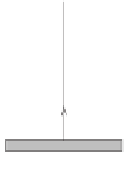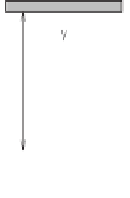Environmental Engineering Reference
In-Depth Information
Although this definition of distance suits most people, it isn't really the best
definition for physicists who work with particles travelling close to light speed. As
a result, the metre is sometimes rejected in favour of a distance measure such that
1 unit of distance is equal to the distance travelled by light in 1 second. In these
units, which particle physicists prefer,
c
=
1.
6.1.1 Time Dilation and the Doppler Effect
Conversely, one could define time by specifying a speed and a distance.
For example, we could make a clock by bouncing light between two mirrors
spaced by a known distance, as illustrated in Figure 6.1. We can think of one
'tick' of this clock as corresponding to the time it takes the light to travel
between the two mirrors and back. The time interval between any two events can
then be determined by counting the number of 'ticks' of the light-clock which
have elapsed between the two events. Of course there is nothing special about
light here, for example we could define time by bouncing a ball between two
walls.
d
light
Figure 6.1
A light-clock viewed in its rest frame.
This is a good place to discuss exactly how time measurements are to be made.
Consider an observer in some frame of reference
S
whoisinterestedinmaking
some time measurements. Since Einstein's theory is going to require that we drop
the notion of absolute time, we need to be more careful than usual in specifying
how the time of an event is determined. Ideally, the observer would like to have
a set of identical clocks all at rest in
S
with one clock at each point in space. For
convenience, the observer might choose that the clocks are all synchronised with
each other. The time of an event is then determined by the time registered on a
clock close to the event. Ideally the clock would be at the same place as the event
otherwise we should worry about just how the information travels from the event to
the clock. The observer can then determine the time of an event by travelling to the
clock co-incident with the event and reading the time at which the event occured
(we are imagining that the clock was stopped by the event and the time recorded).
Clearly this is not a very practicable way of measuring the time of an event but that
is not the point. We have succeeded in explaining in principle what we mean by
the time of an event. Most importantly, the time of the event clearly has nothing to
do with where the observer was when the event happened nor whether the observer
actually saw the event with their eyes. We may have laboured this point to excess



